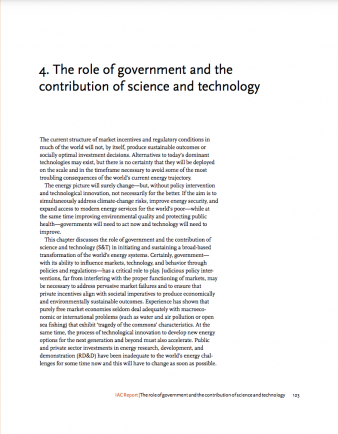Government policies on science and technology
The current structure of market incentives and regulatory conditions in much of the world will not, by itself, produce sustainable outcomes or socially optimal investment decisions. Alternatives to today's dominant technologies may exist, but there is no certainty that they will be deployed on the scale and in the time frame necessary to avoid some of the most troubling consequences of the world's current energy trajectory.
The energy picture will surely change—but, without policy intervention and technological innovation, not necessarily for the better. If the aim is to simultaneously address climate-change risks, improve energy security, and expand access to modern energy services for the world's poor—while at the same time improving environmental quality and protecting public health—governments will need to act now and technology will need to improve.
How can science influence government policies?
This chapter discusses the role of government and the contribution of science and technology (S&T) in initiating and sustaining a broad-based transformation of the world's energy systems. Certainly, government— with its ability to influence markets, technology, and behaviour through policies and regulations—has a critical role to play. Judicious policy interventions, far from interfering with the proper functioning of markets, may be necessary to address pervasive market failures and to ensure that private incentives align with societal imperatives to produce economically and environmentally sustainable outcomes.
Experience has shown that purely free market economies seldom deal adequately with macroeconomic or international problems (such as water and air pollution or open sea fishing) that exhibit 'tragedy of the commons' characteristics. At the same time, the process of technological innovation to develop new energy options for the next generation and beyond must also accelerate. Public and private sector investments in energy research, development, and demonstration (RD&D) have been inadequate to the world's energy challenges for some time now and this will have to change as soon as possible.
At the same time, a more widespread deployment of existing technologies should be pushed by governments even earlier. At their best, government policy and technology RD&D interact in complementary and mutually reinforcing ways. Well-designed policies and regulations can generate a market pull for technologies that are already developed and close to commercialization. At the same time, concerted public and private investments in energy RD&D can push the process of innovation, expanding the menu of technology options that will be available in the future.
Government policies pertaining to science and technology
Related policies—with respect to educating the public, issuing patents, and developing human capital by nurturing a new generation of professionals and scientist with energy expertise—also have a critical role to play. Several recent reports argue that the combination of pull and push mechanisms is likely to be more effective than either approach alone (NCEP, 2004; CBO, 2006).
This chapter also reviews, in general terms, some of the policy levers available to government for advancing sustainable energy objectives, as well as the role of science and technology and some near-term RD&D priorities. At the outset, it is worth remembering that while interest in reducing greenhouse gas emissions per se is relatively new, the history of energy policy and of energy RD&D around the world is rich with experience. Many nations have, at one time or other, sought to advance indigenous fuel sources, reduce conventional energy-related pollutant emissions, develop new technology options, or make energy more widely available. A wide variety of strategies to advance these and other energy-related objectives have been employed, with varying degrees of success. On the one hand, bad energy planning and poorly designed price controls and subsidies, at a rate of more than US$200 billion per year, have distorted markets, produced unintended consequences, and in some cases led to artificial shortages (UNDP, UNDESA, and WEC, 2004).
Similarly, the fact that large sums of public money have been expended on technology programs that have yielded, at best, disappointing results points to the need for improved management of future research & development (R&D) efforts, which should be subjected to continual expert cost/benefit analysis, and to the importance of pursuing the end-goal of shifting technology investments to the private sector.
On the other hand, the record of accomplishment is also impressive. Rural electrification programs have given hundreds of millions more people access to modern energy services. Many countries have successfully nurtured new energy industries, and environmental laws and standards have prompted the development of radically cleaner and more efficient technologies. Around the world, the amount of energy used and pollution generated to produce a dollar of wealth has declined steadily, even as quality of life and access to energy amenities has improved for large segments (though by no means all) of the world’s population.
The role of government and the contribution of science and technology
You can download The role of government and the contribution of science and technology at https://www.interacademies.org/publication/role-government-and-contribution-science-and-technology.

